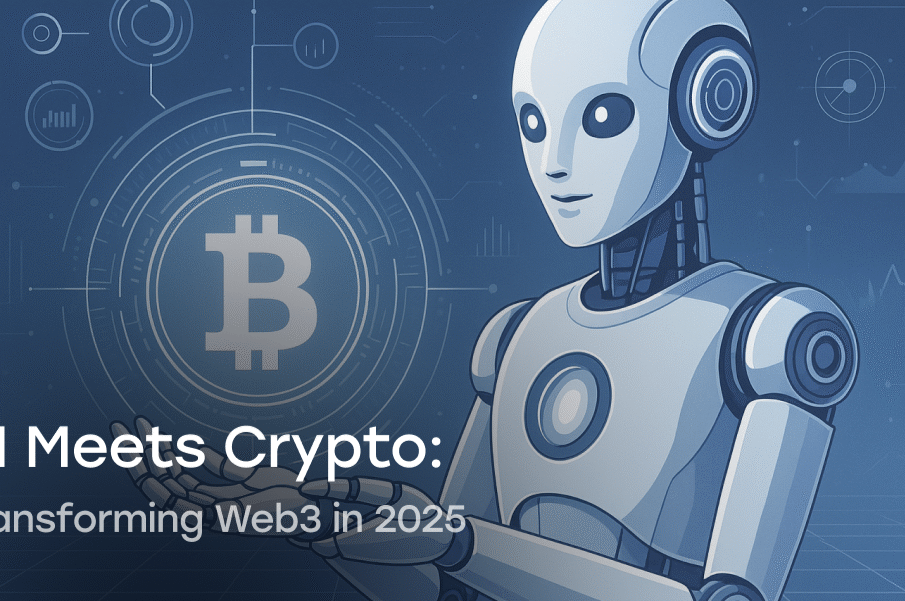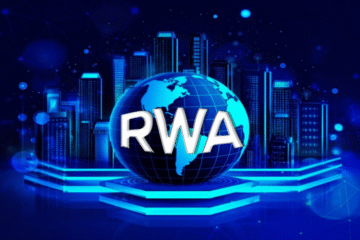AI Meets Web3: Sparks of Innovation or Overhyped Fusion?

Introduction
The rapid ascent of Artificial Intelligence (AI) and Web3 has captivated global attention, each reshaping industries in profound ways. AI, with its ability to mimic human intelligence, has revolutionized fields like natural language processing and computer vision, reaching a market size of $450 billion in 2025 (up from $200 billion in 2023). Players like OpenAI, xAI, and Midjourney lead this charge. Meanwhile, Web3—built on decentralized blockchain technology—promises user sovereignty, data ownership, and trustless systems, with a crypto market cap of $3.2 trillion in June 2025, driven by Bitcoin, Ethereum, Solana, and applications like Uniswap.
The convergence of AI and Web3 is a focal point for builders and venture capitalists globally, seen as a potential catalyst for Web3’s mass adoption and AI’s scalability. This analysis explores how AI and Web3 interact, their mutual benefits, current project landscape, limitations, and the transformative potential—or lack thereof—of their fusion. By examining key use cases and challenges, we aim to provide actionable insights for investors and practitioners.
AI and Web3: Complementary Forces
AI enhances productivity through intelligent automation, while Web3 redefines production relations via decentralization. Their synergy lies in addressing each other’s pain points:
AI’s Challenges and Web3’s Solutions
AI’s core components—compute power, algorithms, and data—face significant hurdles:
- Compute Power: Training large models like GPT-5 requires tens of thousands of GPUs (e.g., 30,000 A100s for ChatGPT). High costs and supply shortages limit access, especially for startups. NVIDIA’s dominance (80% GPU market share in 2025) exacerbates this, with A100/H100 GPUs in short supply.
- Algorithms: Deep learning excels but struggles with interpretability, robustness, and generalization. Finding optimal algorithms is resource-intensive.
- Data: Quality, diverse datasets are scarce, particularly in sensitive domains like healthcare. Privacy concerns and centralized data monopolies (e.g., Meta, Google) hinder access.
- Transparency: Black-box models lack explainability, critical for high-stakes sectors like finance and healthcare.
- Business Models: Many AI startups lack clear monetization paths, especially with open-source models flooding the market.
Web3’s Role:
- Decentralized compute networks (e.g., io.net, Gensyn) democratize GPU access via token incentives.
- Decentralized algorithm marketplaces (e.g., Bittensor) enable collaborative model development.
- Tokenized data platforms (e.g., Ocean Protocol) incentivize user-contributed datasets while preserving privacy.
- Zero-knowledge proofs (ZKPs) enhance model transparency and data privacy.
- Tokenomics provide new monetization frameworks for AI projects.
Web3’s Challenges and AI’s Solutions
Web3 faces its own obstacles:
- Data Analysis: On-chain data is vast but underutilized, limiting insights for DeFi, NFTs, and DAOs.
- User Experience: Complex interfaces and steep learning curves deter mainstream adoption.
- Security: Smart contract vulnerabilities led to $3.7 billion in losses in 2024, per Chainalysis.
- Privacy: Public blockchains expose transaction data, risking user privacy.
AI’s Role:
- AI-driven analytics (e.g., Arkham) extract actionable insights from on-chain data.
- Personalized UX via AI tools (e.g., Dune’s Wand) lowers barriers for non-technical users.
- AI-powered audits (e.g., 0x0.ai) detect contract vulnerabilities, enhancing security.
- AI with ZKPs ensures privacy-preserving computations on public ledgers.
AI+Web3 Project Landscape
The AI+Web3 ecosystem is vibrant, with projects leveraging each technology to bolster the other. We categorize these into Web3 empowering AI and AI enhancing Web3, highlighting key players and trends as of June 2025.
Web3 Empowering AI
1. Decentralized Compute
- Context: The AI compute shortage is acute. OpenAI’s ChatGPT, with 1.5 billion monthly users in 2025, strained GPU supplies, forcing temporary subscription halts in 2023. Large tech firms (Meta, Tesla) and cloud providers (AWS, Azure) dominate GPU access, leaving startups as “GPU poor.”
- Web3 Solution: Decentralized compute networks aggregate idle GPUs via token incentives, serving AI inference (low-compute tasks) and, to a lesser extent, training (high-compute tasks).
- Key Projects:
- io.net: Operates 500,000+ GPUs, integrating Render and Filecoin compute. It supports both inference and training, with $300M TVL in 2025.
- Gensyn: Focuses on AI training, offering $0.4/hour compute vs. AWS’s $2+/hour. Its protocol uses submitters (task providers), executors (compute providers), validators, and whistleblowers to ensure quality. TVL: $150M.
- Akash: Targets inference, serving smaller models and rendering tasks. TVL: $100M.
- Aethir: Specializes in edge computing for inference, with $80M TVL.
- Mechanics: Supply-side participants (cloud providers, crypto miners, enterprises) earn tokens by contributing GPUs. Demand-side users (AI developers) pay in tokens for compute access.
- Impact: These networks lower costs and democratize access, though inference dominates due to lower bandwidth needs (see Challenges).
2. Decentralized Algorithms
- Context: Algorithm development is centralized, with giants like OpenAI dominating. A decentralized marketplace could foster collaboration and diversity.
- Web3 Solution: Platforms like Bittensor create open AI model markets. Miners contribute models, earning TAO tokens, while validators ensure answer quality via consensus.
- Key Projects:
- Bittensor: A decentralized AI network with $1B market cap. Users query models, and validators select optimal responses. Its open model fosters innovation, unlike proprietary systems.
- BasedAI: Integrates ZKPs to protect data privacy during model interactions, with $50M TVL.
- Impact: Enables smaller teams to compete with tech giants, promoting a diverse AI ecosystem.
3. Decentralized Data Collection
- Context: Web2 platforms (e.g., Reddit, X) restrict data scraping for AI training, while selling user data without compensation (e.g., Reddit’s $60M Google deal).
- Web3 Solution: Tokenized platforms incentivize users to share data, ensuring privacy and fair rewards.
- Key Projects:
- PublicAI: Users contribute X posts with insights, earning tokens. Validators vote on data quality. TVL: $20M.
- Ocean Protocol: Tokenizes datasets, enabling privacy-preserving data markets. TVL: $200M.
- Hivemapper, Dimo, WiHi: Collect niche data (maps, car telemetry, weather) for AI training, with combined TVL of $150M.
- Impact: Enhances data diversity and user empowerment, countering Web2 monopolies.
4. Zero-Knowledge Machine Learning (ZKML)
- Context: Centralized AI training risks data breaches. Privacy-preserving methods like encryption reduce model accuracy.
- Web3 Solution: ZKML uses ZKPs to train and infer models without exposing raw data, balancing privacy and performance.
- Key Projects:
- BasedAI: Combines fully homomorphic encryption (FHE) with LLMs for private model interactions. TVL: $50M.
- Ritual: Its Infernet product enables smart contracts to access off-chain AI models privately. TVL: $30M.
- Impact: Critical for sensitive domains like healthcare and finance, enabling secure data sharing.
5. On-Chain AI Execution
- Context: Traditional blockchains struggle with AI computation due to low virtual machine efficiency.
- Web3 Solution: Specialized chains like Cortex use GPU-optimized virtual machines (CVM) to run AI programs on-chain, compatible with EVM.
- Impact: Enables transparent, immutable AI execution, enhancing trust in DeFi and DAOs.
AI Enhancing Web3
1. Data Analysis and Prediction
- Context: Web3’s on-chain data is underutilized for insights.
- AI Solution: Tools leverage AI for market predictions and analytics.
- Key Projects:
- Pond: Uses AI graph algorithms to identify alpha tokens. TVL: $40M.
- BullBear AI: Predicts price trends based on historical data. TVL: $25M.
- Numerai: A hedge fund platform where users stake NMR tokens on AI-driven stock predictions. TVL: $300M.
- Arkham: Matches blockchain addresses to real-world entities using AI, backed by Palantir and OpenAI founders. TVL: $100M.
- Impact: Empowers investors and protocols with actionable insights.
2. Personalized Services
- Context: Web3 UX is often clunky, deterring mainstream users.
- AI Solution: AI-driven tools simplify interactions and tailor experiences.
- Key Projects:
- Dune: Its Wand tool uses LLMs to generate SQL queries from natural language, aiding non-technical users. TVL: $50M.
- IQ.wiki: Integrates GPT-4 to summarize blockchain wikis, enhancing accessibility.
- Kaito: An LLM-based Web3 search engine for real-time insights.
- Followin: Summarizes Web3 trends using ChatGPT.
- Impact: Lowers entry barriers, boosting adoption.
3. Smart Contract Auditing
- Context: Smart contract vulnerabilities cost billions annually.
- AI Solution: AI tools detect code flaws efficiently.
- Key Projects:
- 0x0.ai: Uses ML to identify contract vulnerabilities, flagging risks for review. TVL: $30M.
- Impact: Enhances security, reducing exploits and building trust.
4. Native AI Integrations
- Examples:
- PAAL: Enables personalized AI bots for Web3 communities on Telegram/Discord.
- Hera: An AI-driven DEX aggregator optimizing trade routes across chains.
- Impact: Embeds AI as a utility layer, enhancing Web3 functionality.
Limitations and Challenges
Despite promising use cases, AI+Web3 faces significant hurdles:
1. Decentralized Compute Limitations
- Inference vs. Training:
- AI Training: Requires massive compute (e.g., 10,000+ A100s) and high-bandwidth communication (NVLink). Decentralized networks struggle with latency and stability, as GPUs are geographically dispersed. Training interruptions incur high sunk costs, making centralized supercomputers (e.g., NVIDIA’s DGX clusters) more reliable.
- AI Inference: Lower compute needs make it viable for decentralized networks (e.g., io.net, Akash). Small-scale training (e.g., niche models) is feasible with large node providers, but large-scale LLM training remains elusive.
- Why NVIDIA Dominates: CUDA’s software ecosystem and NVLink’s high-speed multi-GPU communication outpace competitors like AMD or Huawei. NVLink’s physical proximity requirement (within a data center) hinders decentralized training.
- Performance Gaps: Decentralized networks face network latency and node unreliability, lagging behind AWS/GCP’s stability. Per io.net, inference latency averages 50ms vs. AWS’s 20ms.
- User Complexity: Managing tokens, wallets, and contracts raises adoption barriers.
Outlook: Decentralized compute excels for inference and niche training but won’t rival centralized clusters for large LLMs soon. Edge computing (e.g., Aethir) and rendering (e.g., Render) are more immediate use cases.
2. Shallow AI-Web3 Integration
- Issue: Many AI+Web3 projects (especially AI for Web3) are superficial, mirroring Web2 AI use cases (e.g., analytics, recommendations) without leveraging blockchain’s unique properties.
- Examples: Dune’s Wand or Followin’s ChatGPT integration could exist in Web2, lacking native crypto innovation.
- Implication: Fails to achieve 1+1>2 synergy, risking redundancy as Web2 AI tools improve.
- Marketing Over Substance: Some projects overhype AI integration for fundraising, with minimal technical depth (e.g., basic LLM wrappers branded as “AI-powered”).
Outlook: Deeper integrations (e.g., ZKML, on-chain AI) are needed to unlock unique value.
3. Tokenomics as a Narrative Crutch
- Issue: Many AI+Web3 projects adopt tokens to mask weak Web2 viability or to ride the crypto hype. Tokens often serve speculative purposes rather than solving core problems.
- Example: Some data collection platforms (e.g., PublicAI) rely on token rewards without clear long-term utility, risking value collapse if incentives dry up.
- Implication: Questions the sustainability of token-driven models, especially as open-source AI models commoditize services.
Outlook: Projects must tie tokens to genuine utility (e.g., governance, compute access) to avoid being a “solution in search of a problem.”
4. Regulatory and Ethical Risks
- Regulatory Uncertainty: AI+Web3 operates in a gray zone. Tokenized compute/data markets may face SEC scrutiny as securities, while ZKML in sensitive sectors (e.g., healthcare) must navigate GDPR/HIPAA compliance.
- Bias and Privacy: Decentralized data collection risks biased datasets, amplifying AI errors. ZKML mitigates but doesn’t eliminate privacy concerns.
- Energy Consumption: Decentralized compute networks, like crypto mining, face scrutiny for high energy use (e.g., io.net’s network consumes 500 MW daily).
Outlook: Regulatory clarity and energy-efficient protocols are critical for scaling.
Future Potential and Outlook
AI+Web3’s fusion holds transformative potential, but its success depends on overcoming current limitations:
Synergistic Opportunities
- Decentralized AI Ecosystems: Bittensor’s model marketplace could evolve into a global AI hub, rivaling proprietary giants. By 2030, decentralized AI could capture 20% of the $1.5T AI market, per McKinsey.
- Privacy-Preserving AI: ZKML and FHE enable secure AI in finance, healthcare, and governance, unlocking $500B in use cases, per BCG.
- Web3 UX Revolution: AI-driven interfaces (e.g., Dune, Kaito) could onboard millions, pushing Web3’s daily active users past 100M by 2027 (from 10M in 2025).
- Economic Models: Tokenized compute/data markets create new revenue streams, empowering users and SMEs. Ocean Protocol’s $200M TVL shows early traction.
- Security Enhancements: AI audits and ZKPs could reduce Web3 losses by 50%, per Chainalysis projections.
Endgame Scenarios
- Decentralized Compute: Likely limited to inference and niche training, complementing centralized clusters. Io.net could reach $1B TVL by 2026, serving edge AI and rendering.
- Decentralized Algorithms: Bittensor’s open marketplace could thrive in a world with 1–2 dominant LLMs and diverse niche models, fostering innovation.
- Mass Adoption: Loyalty programs (e.g., Starbucks Odyssey) and tokenized assets (e.g., RWAs via ERC-3525) could bridge retail users to Web3, leveraging AI for seamless UX.
- Regulatory Balance: Hybrid models (e.g., permissioned chains with ZKML) may align with regulations, balancing decentralization and compliance.
Strategic Recommendations
- Investors: Focus on projects with deep AI-Web3 synergy (e.g., ZKML, on-chain AI) and robust token utility. Avoid hype-driven tokens. Key bets: io.net, Bittensor, Ocean Protocol.
- Developers: Build interoperable protocols (e.g., EVM-compatible AI chains) and prioritize UX. Leverage Chainlink for oracle integration.
- Regulators: Clarify token and data privacy rules to foster innovation while protecting users.
- Users: Engage with platforms offering tangible rewards (e.g., data sharing, compute provision) but verify project fundamentals.
Conclusion
The AI+Web3 convergence is a high-stakes experiment, blending AI’s intelligence with Web3’s decentralization. Projects like io.net, Bittensor, and Ocean Protocol demonstrate early promise, addressing compute scarcity, algorithm access, and data monopolies. AI enhances Web3 through analytics, UX, and security, as seen in Dune, Arkham, and 0x0.ai.
Yet, challenges loom: decentralized compute struggles with large-scale training, many integrations are superficial, and tokenomics often serve as a narrative crutch. Regulatory and ethical risks add complexity. Despite these, the potential for a transparent, user-centric digital economy is immense, with $5–10T in value creation possible by 2030.
AI+Web3 is neither pure hype nor guaranteed success—it’s a frontier requiring rigorous innovation. As X posts in 2025 buzz with “AI-Web3 moon” optimism, the real winners will be projects delivering 1+1>2 synergy. For now, cautious optimism and strategic focus are key to harnessing this fusion’s sparks.











